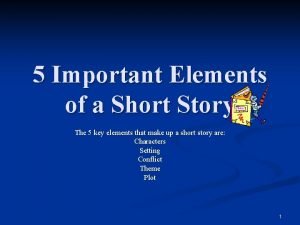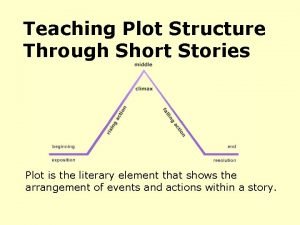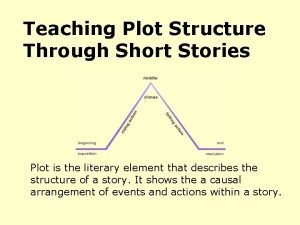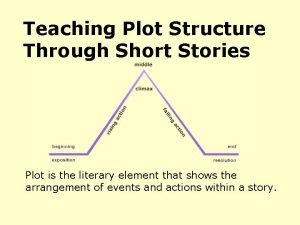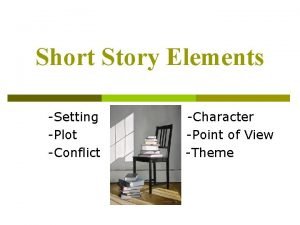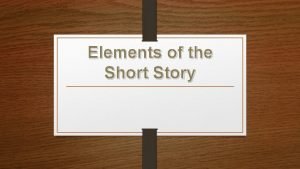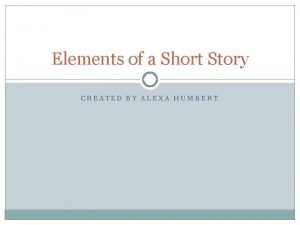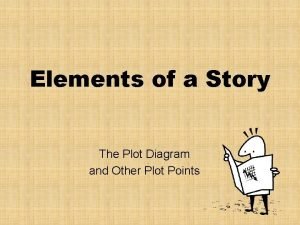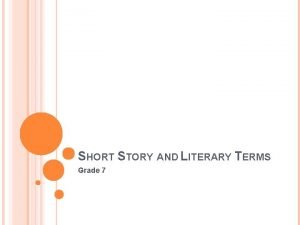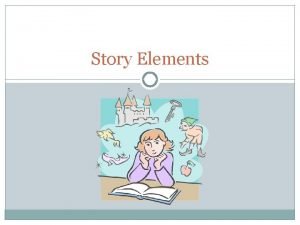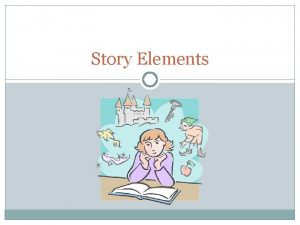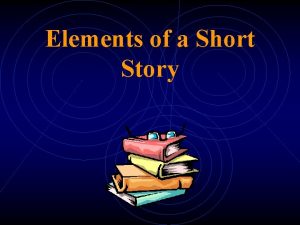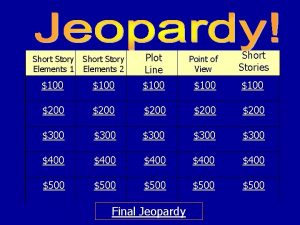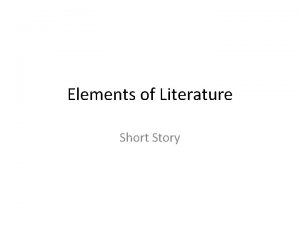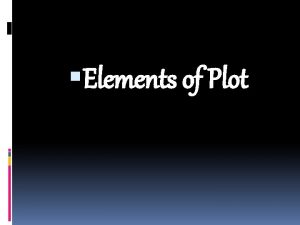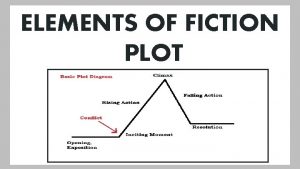Plot The Elements of a Short Story Each














- Slides: 14

Plot The Elements of a Short Story

Each event in a plot ‘hooks’ our curiosity and pulls us forward to the next event…” ¢ ¢ ¢ It is the author’s arrangement of incidents in a story It is the organizing principle that controls the order of events Events can be presented in a variety of orders l l Chronological order (1 st, 2 nd, 3 rd, etc. ) Some begin at the end and lead up to how/why events worked out as they did

Events can be presented in a variety of orders l l l Chronological order (1 st, 2 nd, 3 rd, etc. ) Some begin at the end and lead up to how/why events worked out as they did Some stories begin in the middle of things: • The Latin term for this is “in medias res” l l Some stories go back and forth between past and present Another common strategy is flashback, a device that informs us about events that happened before the opening scene of a work

Conflict: The Fuel of Narrative ¢ A conflict is a struggle that takes place between many things: l l l ¢ ¢ It might take place between two characters It might take place in the character’s mind It might take place between the character and something non-human Internal conflict—takes place inside a character’s mind External conflict—takes place between the character and anyone / anything else

The “Bare Bones” of Plot Climax Rising Action or Complication Basic Situation or Exposition Falling Action or Denoument

These four “bare bones” support a series of events that are intended to hook our curiosity ¢ We are hooked by the characters and their struggle ¢ Now you try to complete a “bare bones” for Cinderella or Finding Nemo ¢

An Exercise in Critical Thinking and Writing Essay #1

Plot Analysis Essay ¢ Using all Lawndale High School Essay expectations, consider the plot in _______ and discuss/analyze how the author uses events, conflict(s), character(s), and action to create an engaging and effective narrative.

Background ¢ To summarize means simply “to state the main points in brief form”. Include the following: 1. 2. 3. 4. The summary should include all the story’s important events The summary should state the events in the order in which they occur The summary should explain how one event leads to the next one Tell how the story uses the key elements of a plot

Prewriting Go back and skim the story’s main events (never rely on your memory) ¢ As you skim, write down all the questions that you ask yourself as you are reading ¢ Write them in the order they come to you and leave enough room for answers l Answer your questions in complete sentences l ¢ Organize the details you’ve cited in your answers by putting them in order of the plot

What a plot analysis might look like: In the beginning of his story “Poison” Roald Dahl makes us suspect at once that something is wrong because we are told that Harry’s light is on and because Harry doesn’t move. We soon learn from Harry that the basic situation is this: a krait has crawled onto his stomach and is lying there asleep—or so he says.

What a plot analysis might look like: The conflict of William Faulkner’s “A Rose for Emily” is the driving force of the story’s plot. However, the conflict is not the act of murder, nor is it Miss Emily’s bizarre, reclusive lifestyle. The conflict is located instead in Miss Emily’s background, her history. She is portrayed as a hardened, bitter old woman, but we soon realize she herself is a victim. She has been oppressed her entire life by her domineering father, unable to take a suitor and marry, which is what she desires most. This lifelong oppression becomes the central conflict, and is what drives Miss Emily, causing her “to cling to that which had robbed her” (Faulkner, “Rose” 98).

Checklist for Revision Have you stated the title and author? ¢ Have you included all the story’s most important events? ¢ Have you analyzed the events in the order in which they occurred? ¢ Have you explained how one event causes or leades to another? ¢

REMEMBER!!! DO NOT SUMMARIZE—YOU MUST ADRESS THE “SO WHAT? ”
 Tall + short h
Tall + short h 5 element of a short story
5 element of a short story Example of a short story
Example of a short story Plot of a story
Plot of a story What is plot in a story
What is plot in a story What is a linear plot structure
What is a linear plot structure Short story with setting, character plot conflict and theme
Short story with setting, character plot conflict and theme Short story plot map
Short story plot map Plot setting characters
Plot setting characters Encyclopedia britannica
Encyclopedia britannica Parallel plot short story examples
Parallel plot short story examples The story comes to reasonable ending
The story comes to reasonable ending Short story with characters, setting, and plot
Short story with characters, setting, and plot Short story plot structure
Short story plot structure Short stories for grade 7
Short stories for grade 7

